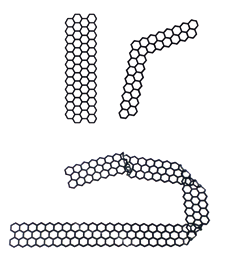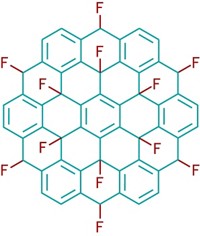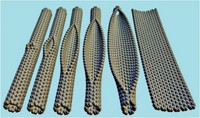Advertisement
Grab your lab coat. Let's get started
Welcome!
Welcome!
Create an account below to get 6 C&EN articles per month, receive newsletters and more - all free.
It seems this is your first time logging in online. Please enter the following information to continue.
As an ACS member you automatically get access to this site. All we need is few more details to create your reading experience.
Not you? Sign in with a different account.
Not you? Sign in with a different account.
ERROR 1
ERROR 1
ERROR 2
ERROR 2
ERROR 2
ERROR 2
ERROR 2
Password and Confirm password must match.
If you have an ACS member number, please enter it here so we can link this account to your membership. (optional)
ERROR 2
ACS values your privacy. By submitting your information, you are gaining access to C&EN and subscribing to our weekly newsletter. We use the information you provide to make your reading experience better, and we will never sell your data to third party members.
Materials
Graphene Ribbons
Slim carbon strips show promise as semiconductors
by Bethany Halford
January 28, 2008
| A version of this story appeared in
Volume 86, Issue 4

TYING TOGETHER materials science and chemistry, scientists have developed a chemical method for making carbon ribbons less than 10 nm wide and just one atom thick (Science, DOI: 10.1126/science.1150878). The semiconducting properties of these so-called graphene nanoribbons make them promising materials for electronics applications.
To create the graphene ribbons, Hongjie Dai and colleagues at Stanford University first chemically exfoliate graphite, loosening individual layers of graphene by giving the graphite a 60-second bath in 3% hydrogen in argon gas at 1,000 ??C. They then "tear" the graphene into strips by sonicating the material in solution. Previously, scientists used lithographic patterning to cut graphene into ribbons. But Dai's chemical method yields narrower ribbons with far smoother edges.
Rodney S. Ruoff, a nanoengineering professor at the University of Texas, Austin, says the work is exciting. "It is surprising that such fine ribbons could result from processing through use of ultrasound," he notes, "so there is some underlying mechanics of a fairly selective propagation of 'cracks' or 'tears'" in the exfoliated graphene.
Dai's effort represents a "significant leap" in graphene research, according to Andre Geim, a physics professor at England's University of Manchester. The new work, he says, shows "one needs to make ribbons only a couple of times narrower than were previously reported to make a qualitative change in characteristics and reach a good transistor action required for integrated circuit applications."
To that end, Dai says the slim nanoribbons have useful properties at room temperature that make them promising electronic components for field-effect transistors and sensors. Furthermore, all the nanoribbons that were less than 10 nm wide were semiconducting, unlike their carbon nanotube cousins, which exist as a mix of semiconducting and metallic materials.
Dai says that the electronic performance of nanoribbon-based devices still needs further investigation. In the meantime, he says, the nanoribbons "will provide an experimental test bed for studies of many fundamental electrical, spectroscopic, and spin properties predicted for these materials."





Join the conversation
Contact the reporter
Submit a Letter to the Editor for publication
Engage with us on Twitter